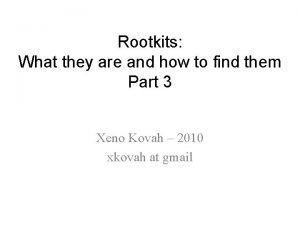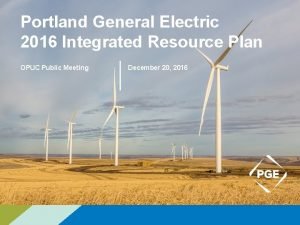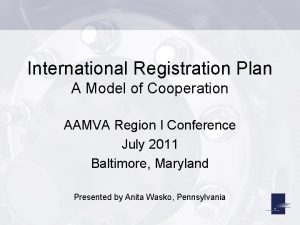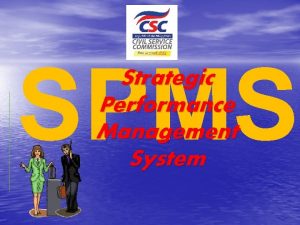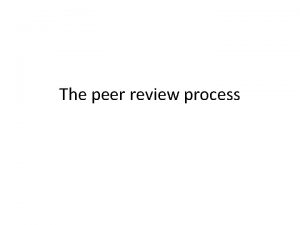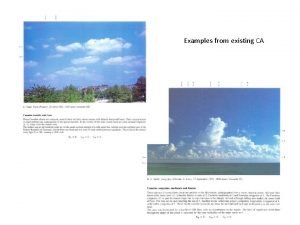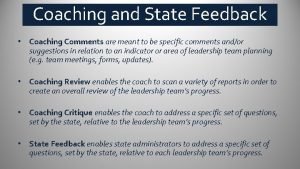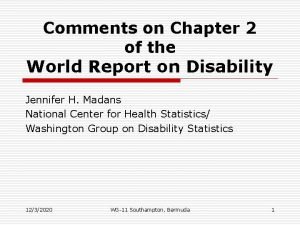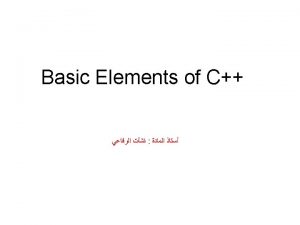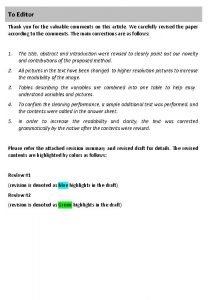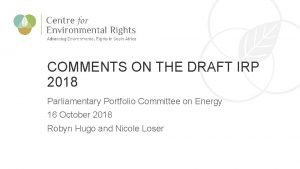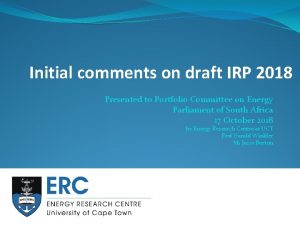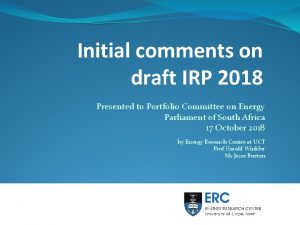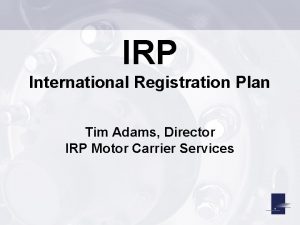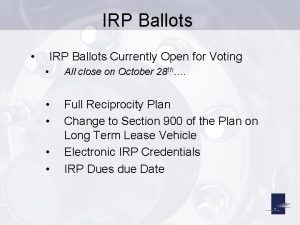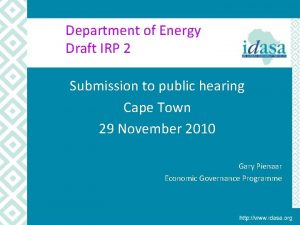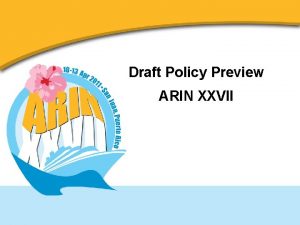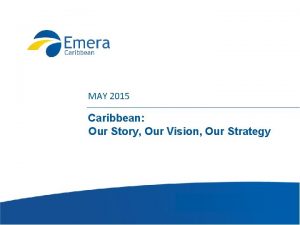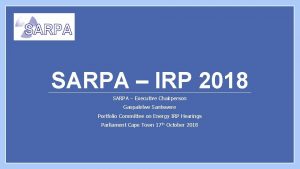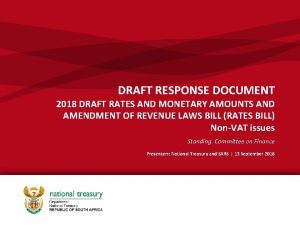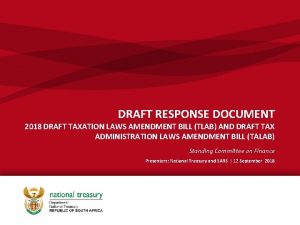Comments on the draft IRP 2018 OUR VISION

























![5. Externalities What about all the other “cost[s] to society because of the activities 5. Externalities What about all the other “cost[s] to society because of the activities](https://slidetodoc.com/presentation_image_h2/8a765f25924c74012cfd318bf921b24b/image-26.jpg)


































- Slides: 60

Comments on the draft IRP 2018

OUR VISION Inspire and mobilise society towards a sustainably developed and equitable low-carbon future. OUR MISSION Bring about significant, positive change in the way we, as humans, engage with earth systems and each other. Support the involvement of South Africans in energy governance a Just Energy Transition.

Outline 1. Planning horizon 2. Lack of urgency (decarbonisation) 3. Just Energy Transition 4. Ownership 5. Externalities

Outline 6. Assumptions 7. Coal 8. Renewable Energy 9. Gas 10. Nuclear 11. Hydro

Focus: Overall concepts and principles rather than fine details and technicalities.

1. Planning Horizon Issue: The draft IRP 2018 has scenarios to 2050 but a recommended plan to 2030 What is certain is that the future is uncertain. Unknowns: demand projections, new technologies, trajectory of economy Ø Need flexible planning, adaptive management while also taking a long term view.

1. Planning Horizon This long term view must be based on underlying principles Ø Address human concerns - Access and affordability of electricity Ø Address environmental concerns - Climate change, pollution, land degradation etc.

1. Planning Horizon What assists in flexible electricity planning? • No mega projects/lock-ins • Distributed and decentralised generators - Small scale, built quickly • Renewables are well suited to this What assists with policy certainty? • Fixed plans for the short to medium term with a long term goal.

1. Planning Horizon What illustrates this long term view in electricity planning? • A recommendation of the path to be taken, based on the best information now, but with the understanding that it will be regularly updated. Ø Here the draft IRP 2018 is problematic as we do not have this indication of what path will be taken post 2030.

1. Planning Horizon • The scenarios differ significantly but we do not know what direction is favoured at the moment. • Climate change mitigation: How do we tell if the plan is compatible with net zero emissions by 2050 if it only goes to 2030?

1. Planning Horizon Recommendations: • Have a fixed short/medium term plan to give policy certainty. • Also have an indicative longer term path that is updated every 2 years into the future.

2. Lack of urgency (decarbonisation) Issue: While the draft IRP 2018 does initiate a shift from fossil fuels to renewables, it is not rapid enough. - Still building new coal - Limiting renewables Climate change commitments: Our Nationally Determined Contribution is “highly insufficient”. * The current Peak Plateau Decline and carbon budget is not ambitious enough. * https: //climateactiontracker. org/countries/south-africa/.

2. Lack of urgency (decarbonisation) Rapid emissions reduction needed NOW!

2. Lack of urgency (decarbonisation) Recommendations: • SA needs a credible carbon budget in line with a 1. 5 o. C average global warming increase above pre-industrial levels. • A fair, maximum carbon allocation must be given to the electricity generation sector. • The IRP MUST be in line with this carbon budget, and a least financial and environmental cost trajectory determined to achieve this. • Remove political obstacles and prioritise a Just Energy Transition.

3. Just Energy Transition Issue: The draft IRP 2018 does not speak to a Just Energy Transition ‘It is not just what you do but how you do it’

What is a Just Energy Transition? (JET) Making the process of shifting to a better energy system as fair and ‘just’ as possible. HOW? Looking after people in the current energy system (such as workers in the coal sector) who could be negatively affected (such as job losses) by this energy transition.

“. . in some scenarios the full-lifecycle costs of building and operating renewables-based projects have dropped below the operating costs alone of conventional generation technologies such as coal or nuclear. ” * Ø Economic case for renewables getting stronger and stronger * https: //www. lazard. com/perspective/levelized-cost-of-energy-2017/

Why do we need a JET? Renewables are now cheaper than alternatives Shift is highly probably due to market economics, but if left to markets alone, there is unlikely to be adequate attention given to social aspects such as worker re-skilling and re-employment.

3. Just Energy Transition Recommendation: • Government must urgently develop a Just Energy Transition Plan, and the IRP must align with this.

4. Ownership Issue: The draft IRP 2018 does not deal with ownership in the electricity sector ‘It is not just what we have, but who owns and controls it’ Ownership is a key component of a JET Electricity sector currently dominated by: • Trans- and multinational corporations • State owned entities

4. Ownership Factors at play: Eskom, as a monopoly state owned entity in the electricity sector, is in major crisis. Opposition to the Independent Power Producers is primarily about privatisation of energy.

4. Ownership From around the world there are success stories of alternative models of ownership at small and large scale. Public, social and community models

4. Ownership https: //90 by 2030. org. za/wp-content/uploads/2018/06/ Just-Energy-Transition-low-res. pdf

4. Ownership Recommendation: • Shift ownership structures in the electricity sector to benefit SA citizens more than the status quo. Ø This is a central part of a JET Plan, which the IRP must align with.

5. Externalities Issue: The draft IRP 2018 only considers the costs of some greenhouse gases and ignores water, ecosystems, climate change impacts. S 3. 2 “Costs of technology, fuel and externalities were therefore major input assumptions during option analyses. ” But S 3. 2. 3: Only financialises emissions from nitrogen oxide, sulphur oxide, particulate matter and mercury.
![5 Externalities What about all the other costs to society because of the activities 5. Externalities What about all the other “cost[s] to society because of the activities](https://slidetodoc.com/presentation_image_h2/8a765f25924c74012cfd318bf921b24b/image-26.jpg)
5. Externalities What about all the other “cost[s] to society because of the activities of a third party resulting in social, health, environmental, degradation or other costs. ”?

5. Externalities Recommendations: • The IRP MUST consider a reasonable set of externalities across all generation technologies, and must include at a minimum: - Water impacts: pollution and usage - Climate change emissions: methane, nitrous oxide - Ecosystem impacts: damage to land, biodiversity loss, soil degradation • Values and methodologies must be verified and referenced.

6. Assumptions Consideration 1: Long term demand forecasts are not reliable Too many unknowns: e. g. When and how will electrification of transport affect demand from utility scale generators? Accept the uncertainty and prioritize flexible, responsive RE generation options as per Section 1

6. Assumptions Consideration 2: Cost trends will push IRP updates towards renewables International cost trends: - Renewables continue to decrease - Fossil fuels flat or increasing - Nuclear underestimated

7. Coal Issue 1: 1000 MW new coal From an environmental, human health, climate change and cost perspective there is no reason to include these https: //cer. org. za/wp-content/uploads/2018/05/ERC-Coal-IPP-Study-Report-Finalv 2 -290518. pdf

7. Coal Issue 1: 1000 MW new coal Justifications: Pg 39 “already procured announced projects” and Pg 39 “Jobs created from the projects will go a long way towards minimizing the impact of job losses resulting from the decommissioning of Eskom coal power plants…”

7. Coal Issue 1: 1000 MW new coal But: • Outstanding licences, environmental authorisations challenged, no financial closure, etc. • Jobs must be addressed through a JET plan Ø Reasoning in the draft IRP 2018 delays the urgent action needed to reskill and re-train coal worker for other sectors.

7. Coal Issue 2: Completing units 5 and 6 of Kusile In addition to the climate change, health, environmental costs of finishing Kusile, there is the straight economic case as determined by Meridian Economics*: “. . it will be more economic to cancel the construction of Kusile units 5 and 6 than to complete it. . , ” *http: //meridianeconomics. co. za/wp-content/uploads/2017/11/Coal. Gen-Report_Final. Doc_For. Upload-1. pdf

7. Coal Issue 3: Decommissioning schedule The decommissioning schedule remains unchanged from the draft IRP 2016 despite good reason to bring it forward. 1. Eskom is again trying to postpone meeting minimal emission standards 2. Eskom could save money by earlier decommissioning (over R 12 Bn for 3 of the older power stations*) 3. Faster transition to a low carbon electricity sector *http: //meridianeconomics. co. za/wp-content/uploads/2017/11/Coal. Gen-Report_Final. Doc_For. Upload-1. pdf

7. Coal Issue 4: EMSEZ

7. Coal

7. Coal • The IRP must contain ALL utility scale electricity generators. • If EMSEZ goes ahead it must get power from low carbon sources.

7. Coal Recommendations: • No new coal (including EMSEZ) • Curtail Kusile construction • Bring decommissioning forward All this MUST happen in line with a JET plan to protect workers in the coal sector.

8. Renewable Energy (RE) Issue 1: Annual build limits Pg 34: “The scenario without RE annual build limits provides the least-cost option by 2030. ” and to 2050 (pg 36) But then a policy adjustment is introduced: Pg 39 “A least-cost plan with the retention of annual build limits (1000 MW for PV and 1600 MW for wind) for the period up to 2030. This provides for smooth roll out of RE, which will help sustain the industry. ”

8. Renewable Energy (RE) Issue 1: Annual build limits a) No explanation on how the 1000 and 1600 MW limits were calculated. b) If no limits provides the least cost option, why does the plan have limits? c) We need to decarbonise as fast as possible, so why limit progress?

8. Renewable Energy Issue 2: Gap in renewables growth Remember the quote about “smooth roll out”? • This is the opposite • Deter investment in a local RE sector

8. Renewable Energy Issue 2: Gap in renewables growth • If over-capacity is the concern: Ø Bring coal decommissioning forward to balance supply • Coal units planned to be offline in 2022 to 2024 due to emissions abatement retrofit

8. Renewable Energy (RE) Recommendations: • No build limits on RE • Capacity must be added EVERY year • Move to a RE dominated system as fast as we can via a JET

9. Gas Issue 1: Very little information on all the new gas capacity a) What is the source of this gas? Fig 11 “All scenarios contain similar volumes of gas to power which is likely to be imported” b) How would it be transported? Does this involve major piping infrastructure?

9. Gas c) Is fracking planned? Must be ruled out due to risks of damage to underground water in the Karoo. d) More local offshore gas? Last attempt to find local offshore reserves (Project Ikhwezi) was the main contributor to Petro. SA’s record loss of R 14. 5 Bn in 2017 * * https: //www. news 24. com/South. Africa/News/petrosa-on-the-brink-after-r 145 bn-loss-20170625 -2

9. Gas 5. Has biogas been explored?

9. Gas Issue 2: Potential negative impacts of gas a) Methane is a much more potent GHG than CO 2 b) Main issue is methane leaks in gas life cycle c) Leakage rates underestimated d) Liquefied natural gas also has high methane emissions. * https: //www. foeeurope. org/sites/default/files/extractive_industries/2017/can_the_climate_afford_europes_gas_addiction_report_november 2017. pdf

9. Gas Issue 2: Potential negative impacts of gas “When taken as a whole, the greenhouse gas emissions at every stage from gas exploration to gas consumption, combined with the environmental, social and health impacts associated with gas extraction, make gas a source of energy that is anything but clean and safe” * https: //www. foeeurope. org/sites/default/files/extractive_industries/2017/can_the_climate_afford_europes_gas_addiction_report_november 2017. pdf

9. Gas Recommendations: • Gas expansion must be carefully researched (and supplied to the public) • To compliment RE there are other options: - Energy efficiency - Storage (not just batteries) - Demand response

10. Nuclear Opinion Despite having low operational emissions, nuclear is not required in SA to combat climate change because we have options that score better on: - Cost - Construction time - Transparency - Non-hazardous waste - Flexibility/scale - Decentralised and distributed - Complexity (Mega-projects) - Risk

10. Nuclear Issue 1: Is nuclear still on the cards post 2030? What are scenarios 6 and 7?

10. Nuclear Trying to meet a carbon budget while limiting renewables

10. Nuclear Recommendations: • Run ambitious carbon budget scenarios with NO RE limits post 2030. (with credible assumptions, revised decommissioning schedule etc. ) • The full modelling information must be made available to the public. • If this modelling indicates no future need for nuclear, then resources earmarked for further expansion of the nuclear fleet must be redirected (Koeberg waste management, JET etc. )

11. Hydro Issue 1: Inclusion of 2500 MW of hydro power from Grand Inga in 2030 • Under construction for a decade • Transmission lines (not built yet) would probably traverse DRC, Zambia and Zimbabwe.

11. Hydro Q: Why would one transmit power from so far away (3350 km) when we have sufficient resources in SA? A:

11. Hydro

11. Hydro Research in 2018 from University of California, Berkeley *: • Due to Inga, the South African power system costs could increase by up to R 4. 3 Bn annually by 2035 • Maximum costs to SA: - Low load growth forecast - Cost overruns for Inga 3 * Renewable Energy Alternatives to Mega-hydropower: A Case Study of Inga 3 for Southern Africa

11. Hydro Recommendations: • Electricity planning must be rational and in the best interests of all our citizens. • The inclusion of this 2500 MW in 2030 appears to be politically motivated, and should be removed.

Conclusion • The draft IRP 2018 is an improvement on the draft IRP 2016, but there are important issues that still need to be addressed. • Project 90 by 2030 and other civil society organisations are willing to help in producing a plan that is best for our people and environment.

Thank you
 Relation between actual draft and mechanical draft
Relation between actual draft and mechanical draft Interest rate parity arbitrage
Interest rate parity arbitrage Cyber disaster planning
Cyber disaster planning Irp commerce
Irp commerce Hardware interrupts and dpcs
Hardware interrupts and dpcs Nysed irp
Nysed irp Gatech cs 4001
Gatech cs 4001 Acalasia classificazione di chicago
Acalasia classificazione di chicago Hxdef100
Hxdef100 Amy newman nida
Amy newman nida Irp 24
Irp 24 Portland general electric irp
Portland general electric irp Aamva international conference
Aamva international conference B a f c j e
B a f c j e Structured light
Structured light Our future is in our hands quotes
Our future is in our hands quotes We bow our hearts we bend our knees
We bow our hearts we bend our knees Our awareness of ourselves and our environment
Our awareness of ourselves and our environment Our census our future
Our census our future Our awareness of ourselves and our environment.
Our awareness of ourselves and our environment. Our census our future
Our census our future Awareness of ourselves and our environment is:
Awareness of ourselves and our environment is: Bernadette farrell christ, be our light
Bernadette farrell christ, be our light Our awareness of ourselves and our environment is called
Our awareness of ourselves and our environment is called Our life is what our thoughts make it
Our life is what our thoughts make it God our father christ our brother
God our father christ our brother Our life is what our thoughts make it
Our life is what our thoughts make it Money madness meaning
Money madness meaning Thinking affects our language which then affects our
Thinking affects our language which then affects our Qet meaning in ipcr
Qet meaning in ipcr Pyp exhibition timeline
Pyp exhibition timeline Comments and suggestions for teachers observation
Comments and suggestions for teachers observation Reviewer comments
Reviewer comments Expectations for unit and ratee examples
Expectations for unit and ratee examples Growing success report card comments
Growing success report card comments Imargey
Imargey Reviewer comments
Reviewer comments Pl/sql supports datatype(s) mcq
Pl/sql supports datatype(s) mcq Commentswrite a comment…
Commentswrite a comment… Housekeeping appraisal comments
Housekeeping appraisal comments Tat in appraisal comments
Tat in appraisal comments 1sg ncoer example
1sg ncoer example Term 2 religion comments
Term 2 religion comments Reviewer comments
Reviewer comments Coaching review comments
Coaching review comments Remarks (general)
Remarks (general) Comments for chapter 2
Comments for chapter 2 Overall well done
Overall well done Ees comment
Ees comment Npqh task 2 example 2019
Npqh task 2 example 2019 Performance review for integrity
Performance review for integrity Think pair share method
Think pair share method Derogatory comments examples
Derogatory comments examples Reviewer comments
Reviewer comments Myp exams
Myp exams What went well comments
What went well comments C++ style comments
C++ style comments Comments for chapter 13
Comments for chapter 13 Thank you for valuable comments
Thank you for valuable comments Write your comments
Write your comments Additional comments uc application
Additional comments uc application








